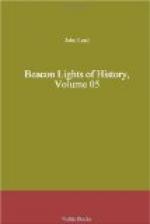Now the Mendicant orders entered with a zeal which has never been equalled, except by the Jesuits, into all the inquiries of the schools, and kindled a new religious life among the people, like the Methodists of the last century. They were somewhat similar to the Temperance reformers of the last fifty years. They were popular, zealous, intelligent, and religious. So great were their talents and virtues that they speedily spread over Europe, and occupied the principal pulpits and the most important chairs in the universities. Bonaventura, Albertus Magnus, Thomas Aquinas, and Duns Scotus were the great ornaments of these new orders. Their peculiarity—in contrast with the old orders—was, that they wandered from city to city and village to village at the command of their superiors. They had convents, like the other monks; but they professed absolute poverty, went barefooted, and submitted to increased rigors. Their vows were essentially those of the Benedictines. In less than a century, however, they too had degenerated, and were bitterly reproached for their vagabond habits and the violation of their vows. Their convents had also become rich, like those of the Benedictines. It was these friars whom Chaucer ridiculed, and against whose vices Wyclif declaimed. Yet they were retained by the popes for their services in behalf of ecclesiastical usurpation. It was they who were especially chosen to peddle indulgences. Their history is an impressive confirmation of the tendency of all human institutions to degenerate. It would seem that the mission of the Benedictines had been accomplished in the thirteenth century, and that of the Dominicans and Franciscans in the fourteenth.
But monasticism, in any of its forms, ceased to have a salutary influence on society when the darkness of the Middle Ages was dispersed. It is peculiarly a Mediaeval institution. As a Mediaeval institution, it conferred many benefits on the semi-barbarians of Europe. As a whole, considering the shadows of ignorance and superstition which veiled Christendom, and the evils which violence produced, its influence was beneficent.
Among the benefits which monastic institutions conferred, at least indirectly, may be mentioned the counteracting influence they exerted against the turbulence and tyranny of baronial lords, whose arrogance and extortion they rebuked; they befriended the peasantry; they enabled poor boys to rise; they defended the doctrine that the instructors of mankind should be taken from all classes alike; they were democratic in their sympathies, while feudal life produced haughtiness and scorn; they welcomed scholars from the humblest ranks; they beheld in peasants’ children souls which could be ennobled. Though abbots were chosen generally from the upper classes, yet the ordinary monks sprang from the peasantry. For instance, a peasant’s family is deprived of its head; he has been killed while fighting for a feudal lord. The family are doomed to misery




